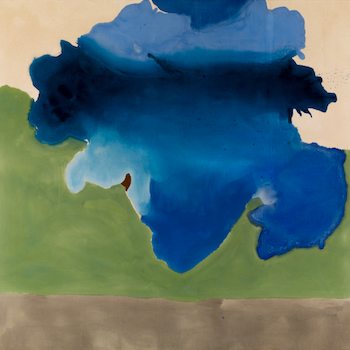Inspired by Helen Frankenthaler - April 15, 2024
 Making art is a great way to reduce stress and express yourself. If you already make art as part of your self-care routine, then you know how much fun it can be. However, sometimes it can be difficult to know where to start.
Making art is a great way to reduce stress and express yourself. If you already make art as part of your self-care routine, then you know how much fun it can be. However, sometimes it can be difficult to know where to start.
Looking at the artwork of others can be an inspiring way to get started with our own self expression. Artists throughout history have studied the work and techniques of the artists who came before them and in the process developed their own style.
“There are no rules... that is how art is born, that is how breakthroughs happen. Go against the rules or ignore the rules, that is what invention is about.” - Helen Frankenthaler
Abstract Expressionism
As defined by the Museum of Modern Art (MoMA):
“Abstract Expressionism is a term applied to a movement in American painting that flourished in New York City after World War II, sometimes referred to as the New York School or, more narrowly, as action painting. The varied work produced by the Abstract Expressionists resists definition as a cohesive style; instead, these artists shared an interest in using abstraction to convey strong emotional or expressive content.”
During the Abstract Expressionism movement, Helen Frankenthaler (1928-2011), developed her unique soak-stain style of painting. She created beautiful abstract paintings by soaking the raw canvas with very fluid paint, allowing it to soak into the canvas. This process resulted in layered washes of color with soft edges that blend into each other, as well as areas of raw canvas peeking through. The effects are soft and calm.
The Bay (pictured here), by Helen Frankenthaler, is part of the collection of the Detroit Institute of Art.
Try This
Get inspired by the art of Helen Frankenthaler!
1. Gather your supplies:
- Paint - acrylic or watercolor - mixed with water to create a fluid, easy to pour paint.
- Raw canvas - you can use a canvas tarp found at hardware stores
- Or use paper and make sure to cover your table to protect it from staining
- Large brushes or rags to move the paint around
2. Next: EXPERIMENT! And remember, “there are no rules…”
Drip, pour, and push your paint around on your canvas or paper, allowing the colors to move and blend.
3. Use paper towels or rags to soak up paint in areas where you are satisfied with the look.
4. Allow your artwork to dry flat before hanging.
Connect with us:
The C.A.R.E. Program team would love to connect with you!
- Register for one of our Caregivers classes
- Join the conversation in our Facebook group
References:
.svg?iar=0&hash=F6049510E33E4E6D8196C26CCC0A64A4)

/hfh-logo-main--white.svg?iar=0&hash=ED491CBFADFB7670FAE94559C98D7798)